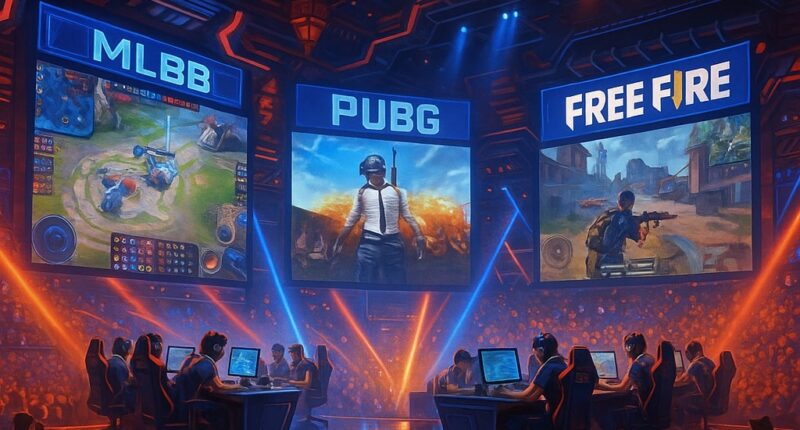Introduction: The Rise of Mobile Gaming in Asia
Over the last decade, mobile gaming in Asia has exploded into a cultural and economic powerhouse. Titles like Mobile Legends: Bang Bang (MLBB), PUBG Mobile, and Free Fire have not only revolutionized entertainment but also reshaped lifestyles, communities, and national identities across the region.
What began as casual mobile fun has evolved into something far larger — a digital movement that defines a generation. These games have transformed smartphones into arenas of competition, cooperation, and creativity. From Manila to Jakarta to Dhaka, mobile gaming isn’t just a pastime — it’s a way of life.
The Big Three: MLBB, PUBG, and Free Fire
MLBB: Southeast Asia’s Homegrown Esports Star
Mobile Legends: Bang Bang (developed by Moonton) is arguably Southeast Asia’s biggest mobile gaming success story. It became the foundation of regional esports, inspiring millions of players across Indonesia, Malaysia, and the Philippines.
The game’s popularity is rooted in accessibility and teamwork. MLBB’s easy-to-learn mechanics and short, intense matches make it ideal for both casual and competitive play. What’s remarkable is how MLBB united the region — turning local teams like Blacklist International, ONIC Esports, and RRQ Hoshi into household names.
Esports tournaments such as the MLBB Southeast Asia Cup (MSC) and M5 World Championship draw massive online audiences, rivaling traditional sports viewership. For many young Southeast Asians, MLBB isn’t just a game — it’s a symbol of regional pride and identity.
PUBG Mobile: The Survival Sensation that Transcended Borders
When PUBG Mobile launched, it redefined what was possible on a phone. Its realistic visuals, survival mechanics, and social interactivity set a new standard for mobile gaming experiences.
In countries like India, Thailand, and China, PUBG Mobile became a cultural force. Players formed squads with friends, streamed matches online, and even organized neighborhood tournaments. During the pandemic, it became a digital social hub — where people connected, laughed, and competed in a shared virtual world.
Esports organizations and sponsors soon followed. The PUBG Mobile Global Championship (PMGC) turned casual players into professional athletes. Millions of fans tuned in to watch their local heroes — proving that Asia wasn’t just consuming global gaming culture but actively shaping it.
Free Fire: The Game of the Masses
While MLBB and PUBG targeted mid-range devices, Free Fire captured the heart of every gamer — even those with low-end phones. Developed by Garena, Free Fire’s success lies in its accessibility and community-driven approach.
It became especially dominant in emerging markets like Bangladesh, Myanmar, Vietnam, and India, where high-end devices are rare. With quick match times and modest hardware requirements, Free Fire turned mobile gaming into a truly inclusive phenomenon.
Garena smartly localized its marketing, using regional languages, pop culture references, and local influencers. In doing so, Free Fire became “the people’s game” — connecting millions of players across class, culture, and geography.
How Mobile Gaming Reshaped Asian Society
1. A New Social Fabric
Mobile gaming in Asia has blurred the line between the virtual and real worlds. These games are not solitary experiences — they’re digital social networks. Players meet, talk, and form friendships through guilds, teams, and in-game chat systems.
In countries like the Philippines and Indonesia, it’s common to see groups of players gathered at cafes or parks, sharing tactics and laughter. Online relationships often extend beyond gaming, creating strong social communities centered around shared passion.
2. The Rise of Esports and Digital Careers
The rise of mobile esports has transformed what it means to be a gamer in Asia. Competitive gaming is now a legitimate career path. Professional players, shoutcasters, analysts, and streamers are becoming digital celebrities.
Events such as the PUBG Mobile Global Championship or MLBB World Championship attract millions of viewers on YouTube and TikTok. Prize pools often reach into the millions, and corporate sponsors from brands like Samsung, ROG, and Pepsi are flooding the scene.
This booming esports economy has inspired governments to recognize gaming as a professional industry. Countries like Indonesia, Malaysia, and Vietnam have integrated esports into their national sports programs — legitimizing what was once seen as a hobby.
3. Economic and Technological Growth
Mobile gaming has also fueled massive technological and economic development in Asia. The demand for better gaming experiences has accelerated smartphone innovation, internet infrastructure, and digital payment systems.
Streaming platforms such as YouTube Gaming, Nimo TV, and TikTok Live have become key tools for content creators. Gaming influencers now earn full-time incomes through sponsorships, donations, and brand partnerships.
In many ways, mobile gaming has become a gateway to the digital economy, empowering young people with opportunities that didn’t exist a decade ago.
4. Pop Culture and Identity
The influence of MLBB, PUBG, and Free Fire extends far beyond gameplay. These titles have infiltrated music, fashion, and media.
K-pop idols, hip-hop artists, and influencers collaborate with game developers for special events and themed content. From PUBG Mobile x BLACKPINK to Free Fire x BTS, crossovers between gaming and pop culture are redefining entertainment across Asia.
In some countries, mobile gaming has become a point of national identity. Players proudly represent their flags during international tournaments, fostering unity and pride in a region known for its diversity.
The Challenges Behind the Success
While the rise of mobile gaming in Asia is inspiring, it’s not without challenges.
1. Gaming Addiction and Screen Time
Excessive gaming has led to concerns over mental health and productivity, particularly among students. Governments in China and India have implemented policies to limit gaming hours for minors.
2. Internet and Device Accessibility
Not every region in Asia has stable internet or affordable devices. Cloud gaming and 5G expansion may help bridge this gap, but infrastructure inequality remains a challenge.
3. Competitive Saturation
As esports grow, competition intensifies. Many aspiring players struggle to find opportunities or financial stability in an oversaturated field. The need for sustainable esports ecosystems — with fair pay and mental health support — is more important than ever.
The Future of Mobile Gaming in Asia
As technology advances, mobile gaming in Asia is poised to reach even greater heights. The arrival of 5G networks, cloud gaming, and AI-driven matchmaking will further enhance performance and accessibility.
Future games will integrate virtual reality (VR) and augmented reality (AR), creating even deeper immersive experiences. Developers are also focusing on storytelling, localization, and cultural representation — ensuring that Asian players see their own identities reflected in the games they love.
Beyond entertainment, mobile gaming will continue to influence education, marketing, and communication, becoming an integral part of Asia’s digital future.
Conclusion: More Than Just Games
MLBB, PUBG, and Free Fire have done more than entertain — they’ve transformed Asia’s social and digital landscape. They’ve given rise to communities, careers, and cultures that connect millions of people across borders.
This is more than a gaming revolution — it’s a cultural renaissance. In every corner of Asia, from the bustling streets of Jakarta to the villages of Myanmar, mobile gaming is proof that innovation and connection know no limits.
The future of gaming is not just global — it’s Asian, and it’s being shaped by the players who found unity, identity, and opportunity in the palm of their hands.









